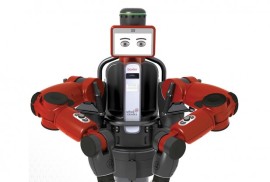THEY NEVER TIRE: Investing in Robotics
Tomorrow’s factory workers are tireless, don’t being to a union, take vacations, or ask for raises. They have no healthcare benefits and no embarrassing moments at the company Christmas party.
For basic jobs, robots are ideal employees. Robots will offer such significant cost benefits over time that companies not heavily invested in robotics may find themselves at a huge competitive disadvantage.
Presently, there are presently over 1,000 robotics companies around the world, notes Frank Tobe of The Robot Report. Many of these are start-ups and very few are publicly traded.
Industrial Robotics
Many of the heavy-hitters are overseas and shares can only be purchased through foreign exchanges. These would include industrial heavyweights such as Germany’s KUKA and two Japanese companies, Yaskawa Motoman and FANUC. Of this group, KUKA appears to be experiencing the strongest price momentum.
ABB (ABB) is a Swiss company that trades in the U.S., but only 20% of its sales are from robotics.
There are two smaller domestic companies worth watching. The first is Adept (ADEP), which is building a niche in automated food packaging. The company has been around for thirty years, and its integrated visual recognition systems and gentle grippers make their robots ideal for packing and transporting produce.
Rethink Robotics was started four years ago by iRobot co-founder Rodney Brooks. The company has recently introduced Baxter (see photo), a $22,000 programmable robot that can do simple jobs. Baxter is built to work side-by-side with human workers and communicates through basic facial expressions. The key advantage here is task flexibility and ease of programming. It can be set-up and trained for a new job within minutes. Given its comparatively low price, this robot could pay for itself within a year.
Rethink is not a publicly traded company yet, but there may be back-door way to participate in the company’s success. Amazon founder Jeff Bezos was one of the first investors in the company, which has raised $64m in venture capital since its founding.
Just last year, Amazon purchased Kiva Systems (a group known for its warehouse management robots). It is pure speculation at this point, but the company appears to be putting together the pieces for a completely automated customer order fulfillment system – transforming the retail industry yet again.
Military
At this point, almost all of the major defense companies have some type of drone initiative, including Boeing (BA), General Dynamics (GD), and Northrup Grumman (NOC), and Raytheon (RTN).
The “pure-plays” here for robotics include AeroVironment (AVAV) and iRobot (IRBT). Shares of both companies are reasonably priced, but they each have their own challenges. AeroVironment is stuck in a relatively indefensible position as provider of small-scale UAV’s (unmanned air vehicles) – a segment with low competitive entry barriers to entry. In the case of iRobot, it appears that much of their product line-up is simply maturing. The good news here is that iRobot remains one of the few pure-play robotics companies with any significant exposure to the consumer market.
With tightening defense spending budgets for both the U.S. and Europe, it is difficult to make a strong case for investing in military robotics – at least for a while.
Health Care
The flagship stock for this group is Intuitive Surgical (ISRG), the maker of the da Vinci surgical system. This is a great example of how robotics can augment basic human capabilities. In this case, the technology enables surgeons to make smaller, more precise incisions. This leads to less painful surgeries and faster patient recovery times.
The company has a strong position in prostate and colon surgeries and continues to find new medical applications for its equipment. Intuitive Surgical has seen its share prices grow at a rate of 65% annually for the past five years.
Hansen Medical (HNSN) manufactures flexible robotics for vascular operations and proceedures. Accuray (ARAY) has an interesting product in the Cyberknife – a non-invasive robotic surgical tool for tumors throughout the body.
Beyond robotically-enabled surgeries, chances are that we we’ll see have more telepresence robots in healthcare for caregiving of the elderly. The best example of this is the RP-VITA (Remote Presence Virtual + Independent Telemedicine Assistant), created in a partnership between InTouch Health and iRobot. This serves as a mobile diagnostic platform that also allows for teleconferencing between doctor and patient.
Agriculture
The field for agricultural robotics is wide open, but Deere & Co. (DE) earned an early leadership position. Deere is a reasonably priced stock with a P/E of 12 and a 2% annual dividend yield. The company already has an autonomous lawnmower, and was one of the first to design an unmanned ground vehicle (the R-Gator).
Autonomous grain carts and harvesting tractors are not far away. Robotics are still just a small part of Deere’s business, but it is clear that the company is thinking ahead.
Conclusion
There are at least three trends that we will see in robotics over the coming years:
1) Increased autonomy. This includes the ability to make situation-appropriate judgments
2) Environmental sensitivity. Robots will become better at perceiving their surroundings. This enables…
3) Better integration with human co-workers
In some ways, the state of technology in the robotics industry is where computers were in the late 1970’s. We are slowing moving from away the bulky and high-maintenance robots of the “mainframe” era, but not yet to the point of easy programmability. Rethink Robotics’ Baxter is exciting because it may be one of the first commercial robots with a price-point low enough to allow for widespread commercial use.
While investing in robotics today may be relatively difficult, over the course of the next two or three decades it may be entirely unavoidable. We’ll be seeing robots just about everywhere… and they’ll be seeing us, too.
(January 22, 2013)

